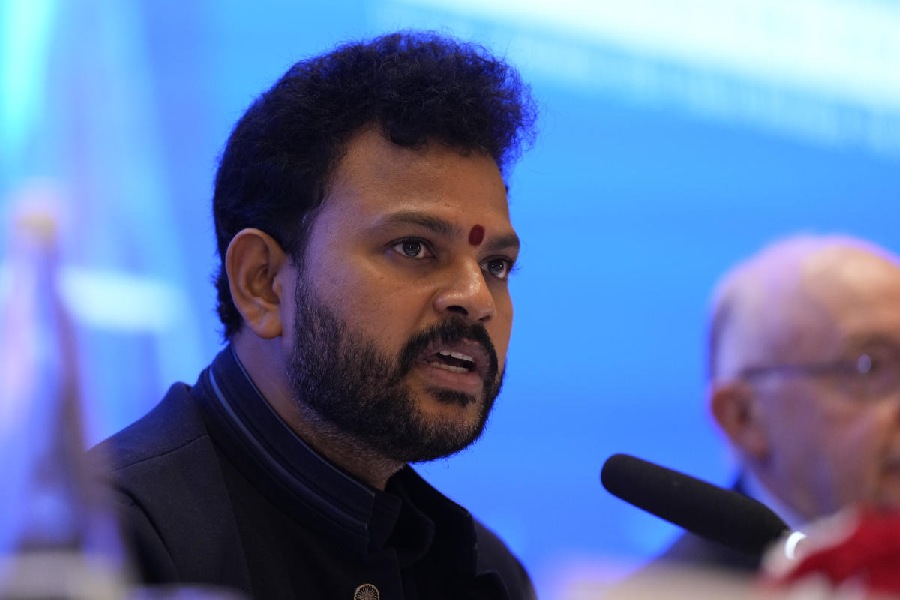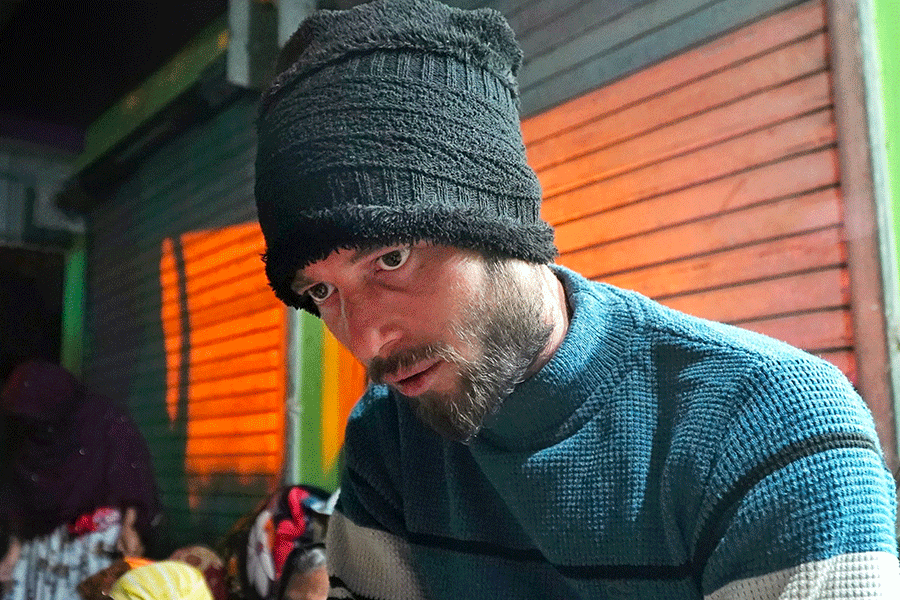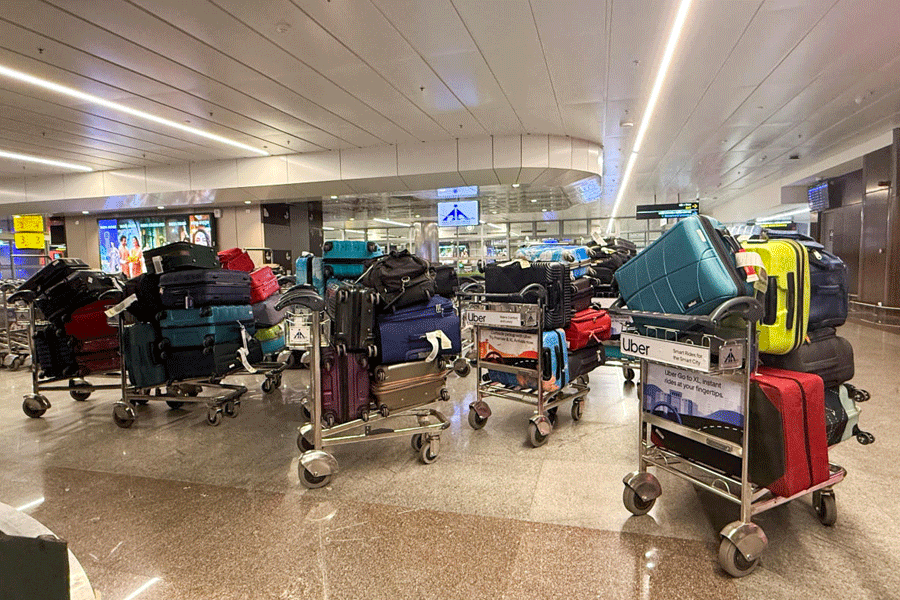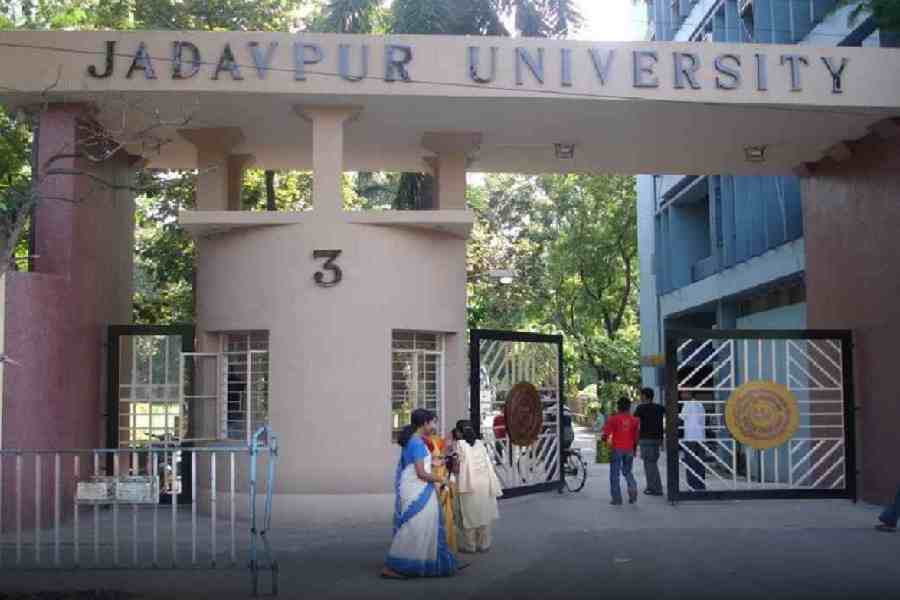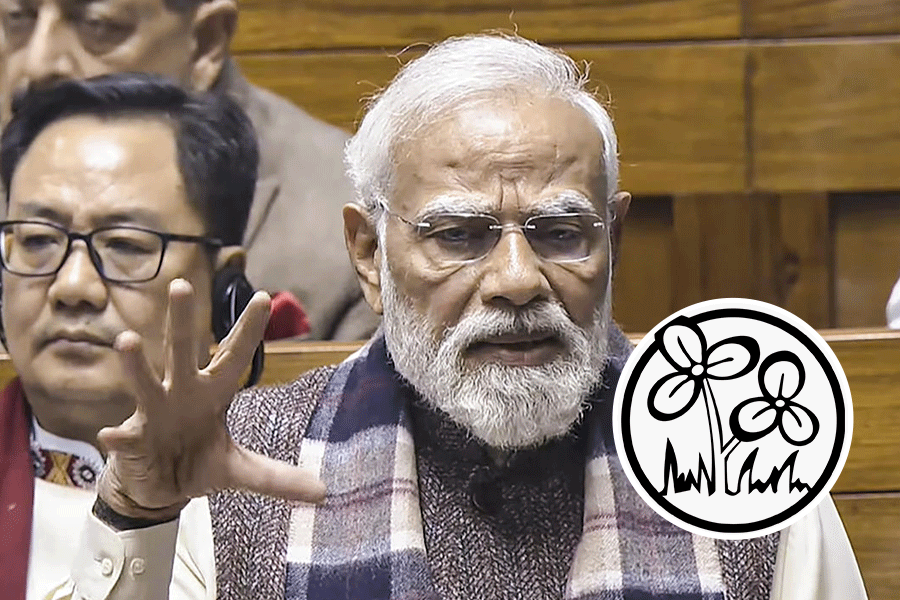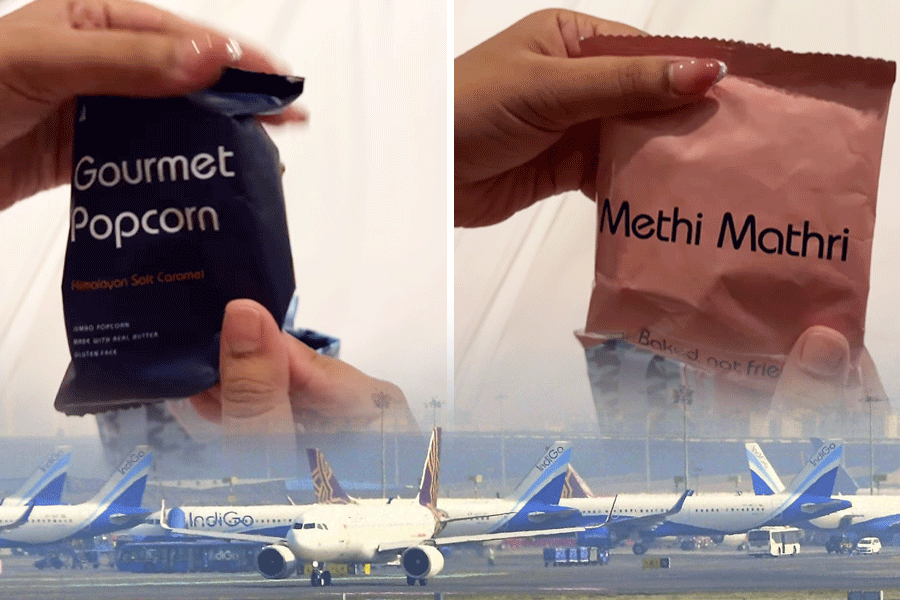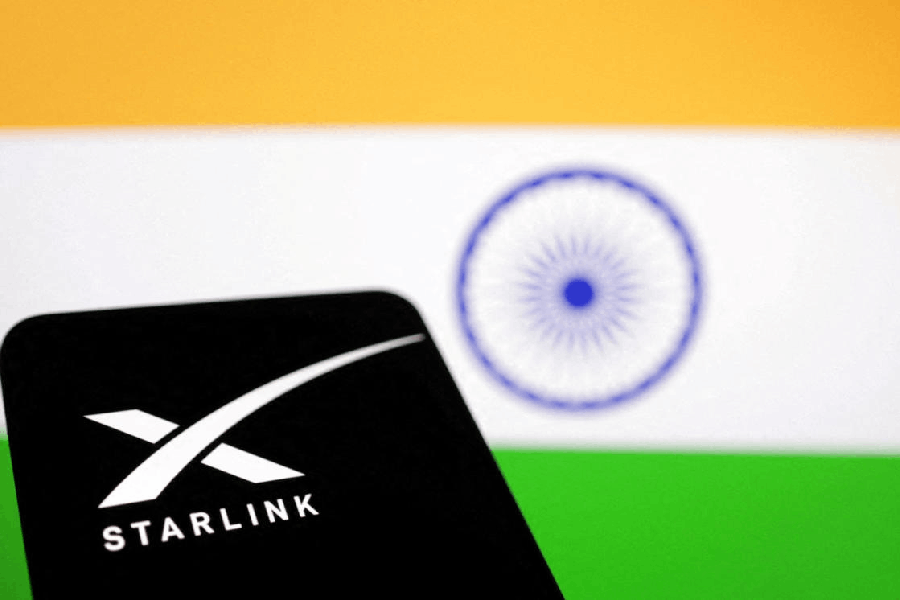A dilapidated structure that stood witness to the rich history of Salt Lake well before the wetlands were filled and the township was born has been unwittingly razed to the ground.
The structure stood on the campus of Bidyadhari Vidayalay, a primary government school in Duttabad beside the Metro viaduct, a stone’s throw from Bidhannagar College. “It was taken down some months back,” children playing in the school ground told The Telegraph Salt Lake on Tuesday. Neither they nor the residents of Bidyadhari Abasan, an eight-storyed structure that has come up behind the school to rehabilitate those displaced by the Metro construction, have any idea of the structure’s vintage.
The same holds for the local councillor. “The school teachers say that the school was started in 1942 (sic), which makes it older than the township. But they have no supporting documents. So I doubt whether it is credible information,” said Rajesh Chirimar, councillor of Ward 39, who is also the mayoral council member in charge of mass education.
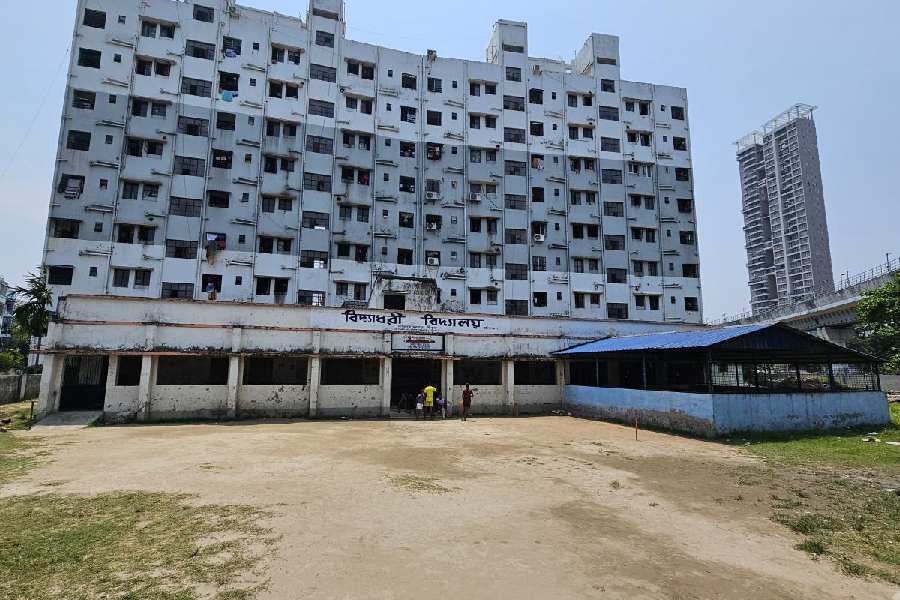
The current singlestoreyed building of Bidyadhari Vidyalay.
Head teacher Nitaichandra Mukherjee, who is aware that the structure was where the school was set up at the behest of the local fishing community before Independence, said the Bidhannagar Municipal Corporation demolished the structure about three-four months ago on request from the school. “Anti-social activities were taking place inside,” he told The Telegraph Salt Lake.
The school owes its name to a branch of the river Bidyadhari that flowed through Rajarhat and what is now Salt Lake city but has long vanished. So has a significant part of the wetlands over which Salt Lake and New Town townships have come up.
“People assume that the history of the area started with the landfill of the 1960s. While that may be the start of the area’s urbanisation, that disregards the economic history of the region and the efforts of the fisherfolk who should rightfully be called the founders of the Salt Lake area,” says Moumita Saha of Deshkal, which has conducted research for over two decades on the area’s economic and political history.
The Telegraph Salt Lake discovered the fate of the structure and alerted Saha and her colleague Shyamal Kumar Ghosh on Tuesday, ironically the day before Salt Lake’s birthday was celebrated commemorating the date of initiation of the Salt Lake reclamation project by the state government in 1962.
The razed structure was the office of the fisherman’s cooperative where they had set up a school for the education of their children. “They may have had little or no education themselves but they successfully ran Asia’s second biggest fishermen’s co-operative in bheris spread over 4,604 bighas, from where Science City stands today till Karunamoyee Housing Estate. Their membership numbered 200 families, while 140 more families were involved in the trade. These are the people who were robbed of a livelihood by the decision to fill up the area which halted their thriving pisciculture and agricultural activities,” say the researchers, quoting the minutes of a meeting held on February 21, 1976. They have published their findings in two volumes, the first of which is titled East Suburban O Salt Lake.

A file picture of people crossing a wooden bridge over Noukhal, a branch of the Bidyadhari at Langolpota, Rajarhat. This is where the river had bifurcated and one arm had entered Salt Lake. That arm has silted up now
“This area was not only the repository of water and other natural resources, including fish, and home to amazing biodiversity but also provided an effective drainage solution to the city. By tampering with the area, we may have secured a housing solution for a growing population but we have also triggered a crisis,” Ghosh says.
Back to the beginning
The British had started pushing Calcutta towards the east, creating Maniktala Poura Sabha in 1879. “The British called it East Suburban Municipality.
It comprised a triangular area starting from Sealdah towards Beleghata, down CIT Road towards Ultadanga. The area had Circular Canal to the left and New Cut Canal to the right. The New Cut Canal, which would later become the Eastern Metropolitan Bypass, was expected to be the eastern boundary of the city,” said Saha.
But after Independence, the Salt Lake township was created. Even that did not suffice as a housing solution. New Town, which was three times the area of Salt Lake, was next in line. “Yet it is on this eastern side that the East Calcutta Wetlands, a most sensitive ecological region, lies. The Hooghly flows at a higher plane. The slope of the city is towards the east, so all the drainage water naturally flows east. Not just the British experts, even the CMDA had warned repeatedly not to extend the city to the east. But we kept repeating the blunder,” she lamented.
Lake to city
If there is increasing ecological imbalance — the temperature of Salt Lake had touched that recorded in the desert city of Jaisalmer in 2023 — the reason might be sought in the lost river Bidyadhari which used to flow through Salt Lake and Rajarhat.
The Bidyadhari is said to have originated in Barga bil near Kalyani, which was fed by the river Yamuna. It bifurcated at Langolpota, a village in Rajarhat ahead of Derozio College, with the left side flowing through Haroa and Bhangore in South 24-Parganas, which is still in existence ahead of Bantala Leather Complex if one travels down Basanti Highway. It flows south as Kulti gaang.
“But there was another branch to the right that used to be the lifeline of Salt Lake-Rajarhat. That has silted up,” Ghosh said, pointing to a conjectural map, not credited and not drawn to scale, that the researchers have found, showing two branches of the Bidyadhari. The century-old map (see far right) shows the Bidyadhari flowing by Arjunpur (near Baguiati), the Mitra building, the house of the zamindar of Salt Lake Gobindaram Mitra, who had built the towering black pagoda, and Kestopur, flowing on towards Chowbhaga (the mouza where The Heritage School stands).
Wherever the meandering Bidyadhari stagnated, it created basins. “The Ghuni-Jatragachhi basin in Rajarhat was an enormous one, and part of it is the current Eco Park. The Bidyadhari basin included the area near Kochpukur, where Aquatica is situated now. The housing complex there, Sanjeeva Town, too came up by filling up the wetlands. Our research suggests that all these areas should have been part of the East Kolkata Wetlands but since the Ramsar site was notified in 2002, all these areas were already filled up and hence not considered,” Saha said.
The British referred to the entire area as Salt Water Lake. According to an old map, the Salt Water Lake started at the foot of Clive House in Dum Dum and flowing through the Ghuni and Jatragachhi belt in Rajarhat, ended in Bhojerhat, near the Bantala leather complex.
In such maps, the Salt Water Lake area is shown to be much bigger than Calcutta, comprising Kalikata, Sutanuti and Gobindapur.
“The British understood that Calcutta could not be saved if the east was not safe. They formed seven committees which put down 11 reasons in support of this. We have also enumerated why a part of the Bidyadhari became extinct,” said Ghosh.
In those days, the Bidyadhari would be used by European traders, especially the Portuguese. “In Kestopur, you still find surnames like Rozario. There is also separate cemetery for them as also a Portuguese church. The church is over 200 years old. There is also a place called Tardaha towards Bhojerhat. The panchayat there is called Tardaha Kapashati. A structure there is locally referred to as Portuguese naachghar. Actually it was the godown of the Portuguese. They used to rest here before proceeding towards the sea,” Ghosh said.
Fishing innovations
Towards the start of the 20th century, the fish that would be cultivated in these bheris were salt-water varieties of fish. Saha wonders why the water of Salt Lake became salty when the Hooghly, that flows by Calcutta, has sweet water, rearing sweet-water fish. “We realised that this arm of the Bidyadhari was connected to the Matla in the Sunderbans, which supplied the salty sea water to Salt Lake, filling up its wetlands during high tide. Thus saline water pisciculture started here. After 1880, when the Dhapa-Manpur dumping site was created, and Calcutta’s sewage water started being drained into the wetlands, pisciculture took a hit. This is because it was sweet water that was being drained in while the fishing community was so long cultivating shrimp and such other salt-water fish. The character of the water was changing,” Saha explained.
The researchers highlight two key figures who played a big hand in the commercial success of the area.
Bidhubhushan Sarkar, of the Beleghata Sarkar family, experimented in what is today’s Nalban by cultivating freshwater fish in the sewage water itself and got great results. The then director of the fisheries department wrote: ‘Sewage-fed fishery is a new addition to the history of fish culture in the world...’ The whole of Salt Lake started following his example and the sewage water ended up being an asset,” he said.
The other person is Bhabanath Sen, a forefather of Justice Shyamal Sen, who took land on lease from the Calcutta Municipal Corporation in 1879. He started garbage mining, thereby creating fertiliser out of dumped garbage, which aided cultivation in the locality.
In 1929, the fishermen’s co-operative was registered on February 27 with 16 signatories. It renamed itself Bidyadhari Spill Matsajibi Samabaya Samity on February 4, 1930. Their registered address was Duttabad, Dum Dum (Salt Lake), 24-Parganas. They took the bheris on lease from the Calcutta Canal Division on an annual payment of Rs 4,500. Their success catalysed the formation of several other fishing cooperatives in the area.
The cooperative shut down on March 31, 1960 in the run-up to the start of reclamation work for the township. The canal division refused to renew their lease, making them take the matter to court but to no avail. The researchers found documents suggesting renewed activity between 1976 and 1979, including agitation for demands of compensation. A meeting was held in this regard at the Bidyadhari Vidyalay on June 19, 1979.
The researchers had traced a teacher from the school, Kamal Mondal, whose father Khagen Mondol was a prominent member of the cooperative. He had told them that mainly six villages comprised the Khasmahal area, with Duttabad being the most heavily populated having a hundred or so huts, and Keoratala the smallest, with two huts. The co-operative office was in Duttabad over five cottahs. A Durga puja would be held there as also jatra pala on festive occasions.
It was this co-operative that established the school on one bigha 1.5 cottah land in 1948. It became a government school in 1962. A second school was established in 1950 but that shut down when the township was being built as it fell within the premises allotted to build the stadium.
He has shared with the Deshkal team how 12 groups of fisherfolk worked in the co-operative, with 14 fishermen in each group. The daily catch would weigh about 400kg.
Wholesellers would queue up from 4am to 9am to buy the fish at Duttabad. Others were involved in repair of boats and making of fishing nets. The boats came from the Sunderbans. Part of the stadium came up on Prabodh Maity’s bheri, locally called Rajar bheri. Bheri no. 3, under the co-operative, became Central Park. That bheri was used for cultivation of both fish and lotus. The waterbody in Banabitan is a remnant of that bheri. Karunamoyee came up partly over Kazir bheri. Sholapith would be cultivated in Nalban, which was vital for weaving of fishing nets.
“Today, the fishermen are missing. Their second or third generation descendants are unaware that their forefathers had created Asia’s second biggest fisheries co-operative. The entire trade was destroyed when the Salt Lake township was developed,” said Ghosh, who has memories of crossing the New Cut Canal in the 1960s at the ghat from Bengal Chemical to Duttabad to reach Salt Lake before the Bypass was built along it.
The only remaining proof of their existence is the school. “We had hoped a wetland museum would come up surrounding the fisheries co-operative office. We had met the school authorities last year and tried to impress upon them the historical significance of their school and the structure which was still standing then. An exhibition on the history of Salt Lake was held as well at Bidhannagar College to which we had invited the school headmistress. But the response was muted,” lamented Saha.
And now with the demolition of the co-operative office, the last trace of Salt Lake’s pre-landfill history is gone.


